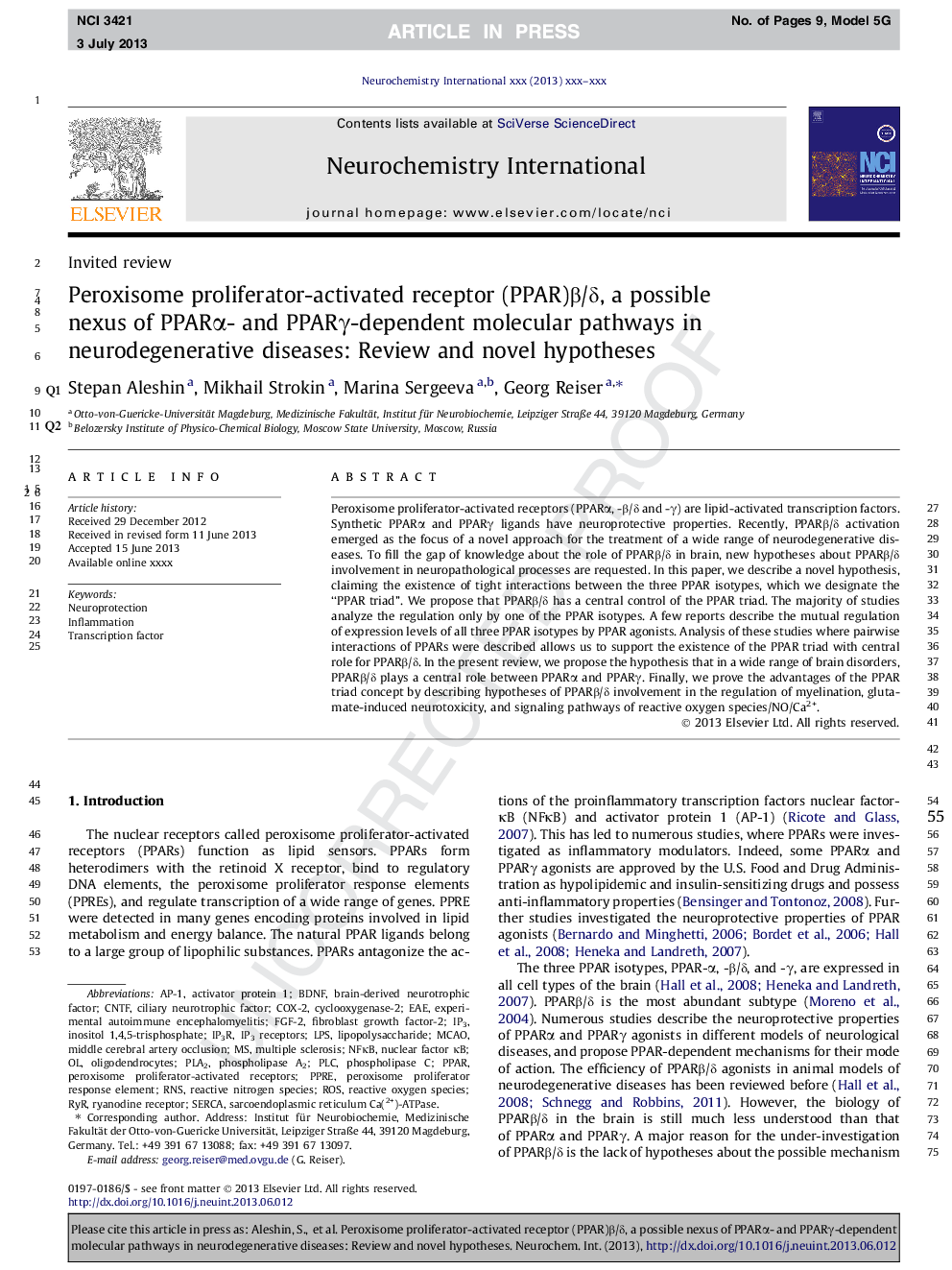| کد مقاله | کد نشریه | سال انتشار | مقاله انگلیسی | نسخه تمام متن |
|---|---|---|---|---|
| 10958192 | 1099977 | 2013 | 9 صفحه PDF | دانلود رایگان |
عنوان انگلیسی مقاله ISI
Peroxisome proliferator-activated receptor (PPAR)β/δ, a possible nexus of PPARα- and PPARγ-dependent molecular pathways in neurodegenerative diseases: Review and novel hypotheses
دانلود مقاله + سفارش ترجمه
دانلود مقاله ISI انگلیسی
رایگان برای ایرانیان
کلمات کلیدی
PLA2FGF-2RyRIP3RPLCAP-1MCAOIP3EAEPPARRNSCNTFCOX-2LPSsarcoendoplasmic reticulum Ca2+-ATPaseBDNF - BDNF یا فاکتور نورونزایی مشتقشده از مغز inositol 1,4,5-trisphosphate - inositol 1،4،5-trisphosphateNFκB - NFKBROS - ROSphospholipase A2 - آنزیم فسفولیپاز A2 experimental autoimmune encephalomyelitis - آنسفالومیلیت خودایمنی تجربیPPRE - ارسالinflammation - التهاب( توروم) middle cerebral artery occlusion - انسداد شریان (سرخرگ) مغزی میانیCyclooxygenase-2 - سیکلوکوکسیژناز2Transcription factor - عامل رونویسیperoxisome proliferator response element - عنصر پاسخ پرولیفراتور پروکسیومBrain-derived neurotrophic factor - فاکتور نوروتروفی مشتق شده از مغزciliary neurotrophic factor - فاکتور نوروتروفیک ciliarynuclear factor κB - فاکتور هسته ای κBphospholipase C - فسفولیپاز Cfibroblast growth factor-2 - فیبروبلاست رشد فاکتور 2SERCA - قلبlipopolysaccharide - لیپوپلی ساکاریدNeuroprotection - محافظت نورونی یا محافظت از عصبMultiple sclerosis - مولتیپل اسکلروزیس(ام اس)activator protein 1 - پروتئین فعال کننده 1reactive nitrogen species - گونه های واکنش پذیر نیتروژنReactive oxygen species - گونههای فعال اکسیژنRyanodine receptor - گیرنده رایانودینPeroxisome proliferator-activated receptors - گیرنده فعال فعال پروکسیومIP3 receptors - گیرنده های IP3oligodendrocytes - یاخته کم شاخه، الیگودندروسیت
موضوعات مرتبط
علوم زیستی و بیوفناوری
بیوشیمی، ژنتیک و زیست شناسی مولکولی
بیولوژی سلول
پیش نمایش صفحه اول مقاله

چکیده انگلیسی
Peroxisome proliferator-activated receptors (PPARα, -β/δ and -γ) are lipid-activated transcription factors. Synthetic PPARα and PPARγ ligands have neuroprotective properties. Recently, PPARβ/δ activation emerged as the focus of a novel approach for the treatment of a wide range of neurodegenerative diseases. To fill the gap of knowledge about the role of PPARβ/δ in brain, new hypotheses about PPARβ/δ involvement in neuropathological processes are requested. In this paper, we describe a novel hypothesis, claiming the existence of tight interactions between the three PPAR isotypes, which we designate the “PPAR triad”. We propose that PPARβ/δ has a central control of the PPAR triad. The majority of studies analyze the regulation only by one of the PPAR isotypes. A few reports describe the mutual regulation of expression levels of all three PPAR isotypes by PPAR agonists. Analysis of these studies where pairwise interactions of PPARs were described allows us to support the existence of the PPAR triad with central role for PPARβ/δ. In the present review, we propose the hypothesis that in a wide range of brain disorders, PPARβ/δ plays a central role between PPARα and PPARγ. Finally, we prove the advantages of the PPAR triad concept by describing hypotheses of PPARβ/δ involvement in the regulation of myelination, glutamate-induced neurotoxicity, and signaling pathways of reactive oxygen species/NO/Ca2+.
ناشر
Database: Elsevier - ScienceDirect (ساینس دایرکت)
Journal: Neurochemistry International - Volume 63, Issue 4, October 2013, Pages 322-330
Journal: Neurochemistry International - Volume 63, Issue 4, October 2013, Pages 322-330
نویسندگان
Stepan Aleshin, Mikhail Strokin, Marina Sergeeva, Georg Reiser,